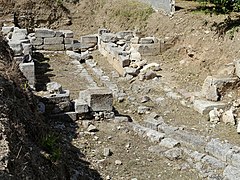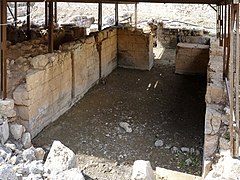Archanes Palace
The Archanes Palace ( Greek Ανάκτορο Αρχανών Anaktoro Archanon ) is an archaeological excavation site in the central north of the Greek island of Crete . It is located within the village of Archanes in the municipality of Archanes-Asterousia in the Heraklion regional district . The oldest building remains uncovered in the Tourkogitonia district ( Τουρκογειτονιά ) date from the Middle Minoan old palace period in the 2nd millennium BC. Chr.
Location and history
The excavation site in the center of the former Turkish quarter of the village of Epano Archanes ( Επάνω Αρχάνες 'Upper Archanes'), within the rows of houses and accessible via a mostly closed access on the west side, only covers a small part of the original extent of the Minoan development. Many parts of the prehistoric buildings lie under the present-day town of Archanes and cannot be uncovered without demolishing the existing houses. At four other places in the village, for example at the church of Agios Nikolaos , further Minoan remains were discovered.
Archanes is over 300 meters altitude in a valley east of Höhenzugs of Giouchtas , according to a myth the grave of Zeus . At its highest point, Psili Korfi , 1.5 kilometers away as the crow flies , there was a summit sanctuary . Other nearby excavation sites from Minoan times are the Phourni necropolis , which probably belongs to Archanes, 950 meters to the north, from which a paved path that was laid out thousands of years ago leads towards Archanes, Anemospilia about 2.5 kilometers to the northwest and Vathypetro 3 kilometers to the south. The distance from Archanes to the north coast of Crete on the Aegean Sea is a little over 11 kilometers, halfway at 6.8 kilometers is Knossos , the assumed center of the Minoan culture.

As early as 1912, Stephanos Xanthoudides underlined the importance of the archaeological site of Archanes. Arthur Evans , who uncovered a Minoan water basin 40 meters northwest of the palace center, referred in 1922 to the “palatial character” of the remains of the wall and suspected the existence of a “summer palace” of the kings of Knossos in Archanes. Subsequent investigations of small areas of the place by Spyridon Marinatos and Nikolaos Platon did not produce any particular results. It was not until 1964 that parts of palatial buildings were discovered under Jannis Sakellarakis and his wife Efi Sapouna-Sakellaraki within Archanes, which had all the characteristics of the palaces of Knossos and Phaistos , such as dimensions, orientation, architecture and the use of valuable building materials, buildings that were both administrative - as were also used for residential purposes.
According to current knowledge, the Archanes palace was built around 1900 BC in the old palace period. Built in BC. This is indicated by found ceramics in the Kamares style . In later phases, small changes were made to the structure until it was around 1700 BC. Was destroyed by an earthquake. From the period 1700 to 1500 BC A 23.5 cm high, 31 × 29 cm large clay house model from Archanes, the modern reconstruction of which is exhibited in the archaeological museum in Heraklion , comes from BC ( Middle Minoan III) . After it was rebuilt and destroyed again by an earthquake a hundred years after the first, the palace complex prospered from 1600 to 1450 BC. In the New Palace period . Characteristic of this cultural section are the marine and flora styles , some of which ceramic vessels were found in Archanes. After 1450 BC The palace of Archanes came under Mycenaean rule and experienced a final period of prosperity.
The exposed remains of buildings in the Tourkogitonia district, which include a propylon , sanctuaries, spacious halls and stairwells, show the neo-palace structures of the central part of the palace complex. Some of the walls still rise up to two meters and are made of stone masonry. The relative thickness of the walls gives rise to the assumption that the building had several, possibly three floors . On the inside of the walls built from different types of stone, wall paintings were often applied and several floors were made from colored mortar. The palace courtyard was on the southeast side of the excavation site, where an entrance between two columns led to a platform with an altar. The fragments of cult vessels, animal bones and a drainage channel towards the southwest for the blood of the sacrificed animals and the cleaning water found here confirm the existence of a sacrificial site for cultic purposes.
In the room to the west of the entrance, sacred utensils, such as vessels and sacrificial tables, were found that originally were probably on an upper floor. The upper floors of the western sector were probably used for residential purposes. On the ground floor, in the walls from the old palace period, relics from the Mycenaean period were found. The westernmost areas of the excavation site were probably used by the palace workshops, as pottery wheels, for example, were exposed there. The discovery of a Linear-A tablet, however, led to the assumption that the archive of the palace was located in the southeastern part of the palace center, which was destroyed by Mycenaean and later layers. A room there also contained ceramics and unworked pieces of rock crystal, obsidian and soapstone , which indicates a workshop. Jannis Sakellarakis, who died in 2010, considered the palace complex to be only a little smaller than the palace of Knossos, making Archanes' second largest palace in the Minoan culture.
- Excavation site
literature
- Stefan Hiller : The Minoan Crete after the excavations of the last decade (= meeting reports of the philosophical-historical class . Volume 330 ). Publishing house of the Austrian Academy of Sciences, Vienna 1977, ISBN 978-3-7001-0176-5 , p. 157-160 .
- John A. Sakellarakis, Efi Sapouna-Sakellaraki: Archanes: Archanes excavations . Ekdotike Athenon, Athens 1991, ISBN 978-960-213-234-0 (English).
Individual evidence
- ↑ Dana Facaros, Michael Pauls: Crete (= Cadogan Guides ). New Holland Publishers, London 2003, ISBN 978-1-86011-106-8 , South from Knossos: Archánes and Myrtiá, pp. 205–206 (English, digitized version [accessed January 22, 2017]).
- ↑ a b c Gerhard Prause: A palace - like that of Knossos . In: The time . No. 38/1977 . Zeitverlag, Hamburg 1977 ( digitized version [accessed on January 22, 2017]).
- ↑ a b c d Antonis Sp. Vassilakis: Crete . Mathioulákis, Athens 1999, ISBN 978-960-7581-01-3 , Archánes, p. 185 .
- ↑ a b Ανάκτορο Αρχανών. Ministry of Culture and Sports, 2012, accessed January 22, 2017 (Greek).
- ↑ Yannis Sakellarakis, Efi Sakellaraki: Archanes-Tourkoyeitonia . In: Wilson J. Myers, Eleanor E. Myers, Gerald Cadogan (Eds.): The Aerial Atlas of Ancient Crete . University of California Press, Berkeley 1992, ISBN 978-0-520-07382-1 , pp. 61 (English, digitized version [accessed on January 22, 2017]).
- ↑ a b c d e Tourkogeitonia. Archanes-Asterousia municipality, accessed January 22, 2017 .
- ^ J. Lesley Fitton: The Minoans . Theiss, Stuttgart 2004, ISBN 3-8062-1862-5 , The Crete of New Palaces, p. 115 (English: Peoples of the Past - Minoans . London 2002. Translated by Tanja Ohlsen).
- ^ Antonis Vasilakis: The Heraklion Archaeological Museum . Adam-Pergamos, Peania 2005, ISBN 978-960-500-264-0 , heyday and late period of the palace of Knossos (1450-1300 BC), p. 101 .
- ↑ a b S. Logiadou-Platonos, Nanno Marinatos: Crete . Mathioulakis, Athens 1971, ISBN 978-960-7310-59-0 , The Palace of Archanes (Turkogitonia), p. 160 .
Web links
- Archanes: Tourgogeitonia. In: Digital Crete: Archaeological Atlas of Crete. Foundation for Research and Technology-Hellas (FORTH), Institute for Mediterranean Studies(English).
- Ανάκτορο Αρχανών . Ministry of Culture and Sports, 2012,accessed January 22, 2017(Greek).
- Tourkogeitonia. Archanes-Asterousia municipality, accessed January 22, 2017 .
- Minoan Palace in Archanes. Tourist Guides of Crete, accessed January 22, 2017 .
- Stelios Jackson: Ancient Archanes. Interkriti, 2004, accessed on January 22, 2017 .
- Arhanes Palace. Cretan Beaches, accessed January 22, 2017 .
Coordinates: 35 ° 14 ′ 11 " N , 25 ° 9 ′ 35.8" E








